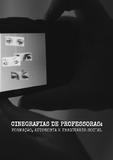| dc.creator | Severo, Bianka de Abreu | |
| dc.date.accessioned | 2021-12-27T18:02:49Z | |
| dc.date.available | 2021-12-27T18:02:49Z | |
| dc.date.issued | 2021-01-08 | |
| dc.identifier.uri | http://repositorio.ufsm.br/handle/1/23421 | |
| dc.description.abstract | This Master's dissertation in Education was developed in Line of Research 1 – Teaching,
Knowledge and Professional Development, of the Post-Graduation Program in Education
(PPGE), at the Federal University of Santa Maria (UFSM). It arose from the interest in
bringing the imaginary closer to the autonomous and heteronomous movements permeated in
the images that teachers have or produce around teaching. The general objective was to
understand the construction of autonomy and the formative paths in the experience of teachers
with cinema. The theoretical foundation included studies in the theoretical field of the Social
Imaginary (CASTORIADIS, 1982, 2004, 2006, 2009; OLIVEIRA, 2005), Teacher Training
(FERRY, 2004; GATTI et al, 2019; NÓVOA, 2009) and Cinema and Education (BERGALA,
2008; FRESQUET, 2013; TEIXEIRA et al 2014). The research-training methodology
(JOSSO, 2004) was carried out in seven collective meetings with cinema, in virtual format,
between june and july 2020, with the co-authorship of four teachers of Basic Education. The
co-author's cinematographies, that is, the narratives based on the appreciation or creation of
films, were understood by the hermeneutic analysis (GADAMER, 1997) and, thus,
constructed the research results. In general, cinematographies have shown that teachers are
attentive to heteronomous movements, however, teaching is largely limited to individual
autonomy. The cinematographies of the letter-films, in particular, highlighted desires,
strangeness, resistance and a creative reading of the teaching images. Regarding the symbolic
place of teachers, society assigns a “task” place, while teachers assign an intellectual place.
Thus, teaching is made of a living matter that, in the micro-revolutions, tensions movements
of agreement and subversion in the context that circumscribes it, operating a life between the
desired and the possible, in which watching and making films are favorable experiences for
the expansion of subversive movements. The research indicated that thinking about the
formative paths through the sensitive path of images is potent both for the exercise of
autonomy and for self-training. | eng |
| dc.description.sponsorship | Coordenação de Aperfeiçoamento de Pessoal de Nível Superior - CAPES | por |
| dc.language | por | por |
| dc.publisher | Universidade Federal de Santa Maria | por |
| dc.rights | Attribution-NonCommercial-NoDerivatives 4.0 International | * |
| dc.rights.uri | http://creativecommons.org/licenses/by-nc-nd/4.0/ | * |
| dc.subject | Formação de professores | por |
| dc.subject | Cinema e educação | por |
| dc.subject | Autonomia | por |
| dc.subject | Imaginário social | por |
| dc.subject | Teacher training | eng |
| dc.subject | Cinema and education | eng |
| dc.subject | Autonomy | eng |
| dc.subject | Social imaginary | eng |
| dc.title | Cinegrafias de professoras: formação, autonomia e imaginário social | por |
| dc.title.alternative | Teacher’s cinegraphies: training, autonomy and social imaginary | eng |
| dc.type | Dissertação | por |
| dc.description.resumo | Esta dissertação de Mestrado em Educação foi desenvolvida na Linha de Pesquisa 1 –
Docência, Saberes e Desenvolvimento Profissional, do Programa de Pós-Graduação em
Educação (PPGE), da Universidade Federal de Santa Maria (UFSM). Ela surgiu do interesse
por uma aproximação dos imaginários sobre os movimentos autônomos e heterônomos
permeados nas imagens que as professoras têm ou produzem em torno da docência. O
objetivo geral foi compreender a construção da autonomia e os trajetos formativos na
experiência de professoras com o cinema. A fundamentação teórica contou com os estudos do
campo teórico do Imaginário Social (CASTORIADIS, 1982, 2004, 2006, 2009; OLIVEIRA,
2005), da Formação de Professores (FERRY, 2004; GATTI et al, 2019; NÓVOA, 2009) e do
Cinema e Educação (BERGALA, 2008; FRESQUET, 2013; TEIXEIRA et al 2014). A
metodologia da pesquisa-formação (JOSSO, 2004) foi realizada em sete encontros coletivos
com o cinema, no formato virtual, entre junho e julho de 2020, com a coautoria de quatro
professoras da Educação Básica. As cinegrafias das coautoras, isto é, as narrativas a partir da
apreciação ou da criação de filmes, foram compreendidas pela análise hermenêutica
(GADAMER, 1997) e, assim, construíram os resultados da pesquisa. Em geral, as cinegrafias
mostraram que as professoras estão atentas aos movimentos heterônomos, porém, a docência
em grande parte é limitada à autonomia individual. As cinegrafias dos filmes-carta,
particularmente, ressaltaram desejos, estranhamentos, resistências e uma leitura criativa das
imagens da docência. A respeito do lugar simbólico das professoras, a sociedade atribui um
lugar “tarefeiro”, enquanto as professoras atribuem um lugar intelectual. Sendo assim, a
docência é feita de uma matéria viva que, nas microrrevoluções, tensiona movimentos de
concordância e subversão no contexto que a circunscreve, operando um viver entre o desejado
e o possível, no qual ver e fazer filmes constituem experiências propícias ao alargamento dos
movimentos subversivos. A pesquisa indicou que pensar sobre os trajetos formativos pela via
sensível das imagens é potente tanto ao exercício da autonomia quanto à autoformação. | por |
| dc.contributor.advisor1 | Oliveira, Valeska Maria Fortes de | |
| dc.contributor.advisor1Lattes | http://lattes.cnpq.br/3628223248832085 | por |
| dc.contributor.advisor-co1 | Miorando, Tania Micheline | |
| dc.contributor.referee1 | Teixeira, Inês Assunção de Castro | |
| dc.contributor.referee2 | Bolzan, Doris Pires Vargas | |
| dc.creator.Lattes | http://lattes.cnpq.br/3093053928094027 | por |
| dc.publisher.country | Brasil | por |
| dc.publisher.department | Educação | por |
| dc.publisher.initials | UFSM | por |
| dc.publisher.program | Programa de Pós-Graduação em Educação | por |
| dc.subject.cnpq | CNPQ::CIENCIAS HUMANAS::EDUCACAO | por |
| dc.publisher.unidade | Centro de Educação | por |



